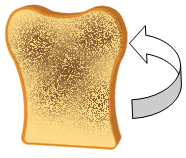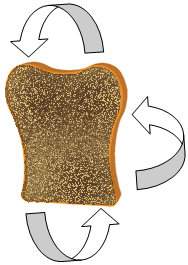Traditional single Insertion method

The traditional method of toasting. You simply adjust the toaster setting so that it pops up cooked to perfection. At least, that’s the idea. The reality is that several factors usually result in very uneven toasting.
Advantages:
- Speed
- Simplicity
- Basic toaster settings
- No special training required
Disadvantages:
- Uneven toasting (unless you use the Breville Toastmatic 4000)
Double insertion method (mid-stage horizontal rotation)

The first level of advanced toast-making. The toaster is set to half the standard setting, and when it pops out midway you rotate the bread horizontally before reinserting for the second stage.
Advantages:
- Consistent toasting on both sides
Disadvantages:
- Top of bread often toasted more than bottom
- Inexperienced users can burn their fingers at the midway stage
- Basic training required
The Uther Henge Flip (mid-stage vertical rotation)

The pinnacle of practical toast-making. This is a simple improvement over the horizontal double insertion method. The introduction of a vertical flip creates fantastic toast.
Advantages:
- Consistent toasting top to bottom on both sides
Disadvantages:
- Resetting toaster to half the single insertion value confuses other toaster users who have to be forcefully inducted into the ways of the Uther Henge Flip.
Horizontal rotation followed by vertical flip followed by second vertical flip

This over-elaborate method of toasting results in the most consistent browning but is so complex that most people get worse results than the traditional single insertion method.
Advantages:
- Incredibly even toasting
Disadvantages:
- Requires quadruple insertion
- Many novices fail to observe the rule that bread should be inserted either once, or an even number of times, but never an odd number, unless of course you introduce a final finishing off phase to remedy any inconsistencies
- Setting the toaster becomes very complex
- Toaster needs to be reset for subsequent slices to prevent over-cooking
- Constant monitoring necessary to avoid burning
- Many people forget how many toast rotations they have performed because they are distracted by other events in the kitchen
Factors to consider
Is your bread sliced by hand or machine?
Hand-slicing is less consistent than machine-slicing and the raised areas can become especially burnt. But you may be able to spread more Hobgoblin Marmalade on hand-sliced bread because it has a greater surface area. Experts call this the Goblin Ratio.
Is the bread thicker at one end than the other?
This can have a massive impact on the flow of hot air through your toaster, disrupting your calculations. You may be wise to set some time aside for wind-tunnel testing if your slices of bread are particularly wedge-shaped.
Who is Uther Henge?
Uther Henge is the chief mystics consultant for the National Trust stationed permanently at their gift shop at Glastonbury Tor. If you visit St. Michael’s Tower on top of Glastonbury Tor you can experience the Making Toast Through The Ages display at which Uther Henge gives a twice-daily lecture Toast, the Tor, Past Present and Future. Henge invented the Uther Henge Flip during one of his lectures when he realised that this unintuitive method of rotating bread resulted in a better and more consistent slice of toast.
Infographic
This information is available as an Making Toast Through The Ages

Comments